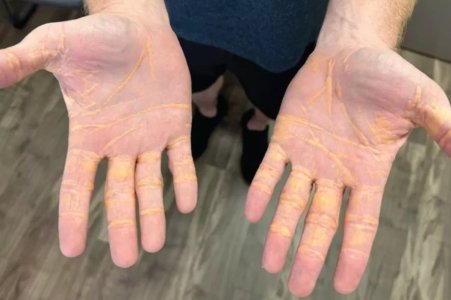Shocking discovery: one man's extreme diet reveals the dangers of high cholesterol buildup
By
Veronica E.
- Replies 0
Have you ever stopped to think about how much your diet truly affects your cholesterol levels and overall health? It’s easy to overlook the long-term effects of our food choices when we’re focused on quick fixes or trendy eating plans.
However, for one man in Florida, his extreme dietary decision led to an eye-opening health crisis that serves as a powerful reminder for us all.
His story, while unusual, highlights the significant role nutrition plays in our well-being—especially as we grow older and our bodies become more susceptible to health challenges.
This isn’t just a rare case; it’s a cautionary tale that emphasizes the importance of maintaining a balanced and thoughtful approach to what we eat.
The carnivore conundrum
This Florida man, from Tampa, decided to try a carnivore diet, focusing almost exclusively on animal-based foods while eliminating carbohydrates entirely.
His diet was loaded with meats, fish, eggs, full-fat dairy, and hefty portions of cheese, butter, and fat-laden hamburgers.
Initially, he reported weight loss, increased energy, and mental clarity.
However, after eight months, something alarming started to happen: he noticed yellowish nodules on his palms, elbows, and soles of his feet.

A cholesterol crisis
The man's cholesterol levels were tested at Tampa General Hospital and the results were alarming—his cholesterol was over 1000 mg/dL, five times higher than the normal range.
These yellowish nodules were diagnosed as xanthelasma, which is when fatty deposits build up under the skin due to high cholesterol levels.
While xanthelasma itself isn’t harmful, it’s a visible sign that cholesterol levels in the body could be dangerously high.
If untreated, high cholesterol can lead to more serious conditions like heart disease, heart attacks, strokes, and aneurysms.
Xanthelasma and your health
The appearance of these yellowish nodules isn’t just an odd skin condition; it’s a sign that cholesterol buildup could be affecting your health in unseen ways. This case serves as a powerful reminder of how dietary choices directly impact lipid levels in the body.
While some diets may bring short-term benefits, they may lead to long-term complications if not carefully managed.
Balancing your diet for healthy cholesterol
This story is a good reminder for all of us—especially as we grow older—of the importance of maintaining a balanced diet. Here are a few tips to help keep your cholesterol in check:
This Florida man’s experience serves as a powerful reminder of how extreme diets can lead to serious health issues. It’s a cautionary tale about moderation and making informed, balanced choices for our health as we age.
As we navigate the complex world of nutrition, let’s be mindful of how our dietary choices impact our well-being.

We’d love to hear your thoughts and experiences. How do you manage your cholesterol levels? What dietary changes have worked for you? Share your tips and let’s keep the conversation going in the comments below!
However, for one man in Florida, his extreme dietary decision led to an eye-opening health crisis that serves as a powerful reminder for us all.
His story, while unusual, highlights the significant role nutrition plays in our well-being—especially as we grow older and our bodies become more susceptible to health challenges.
This isn’t just a rare case; it’s a cautionary tale that emphasizes the importance of maintaining a balanced and thoughtful approach to what we eat.
The carnivore conundrum
This Florida man, from Tampa, decided to try a carnivore diet, focusing almost exclusively on animal-based foods while eliminating carbohydrates entirely.
His diet was loaded with meats, fish, eggs, full-fat dairy, and hefty portions of cheese, butter, and fat-laden hamburgers.
Initially, he reported weight loss, increased energy, and mental clarity.
However, after eight months, something alarming started to happen: he noticed yellowish nodules on his palms, elbows, and soles of his feet.

An extreme case of high cholesterol manifests in the skin, with yellowish nodules appearing on the hands—an alarming sign of the body's lipid imbalance. Image Source: JAMA Cardiology 2025, Marmagkiolis et al.
The man's cholesterol levels were tested at Tampa General Hospital and the results were alarming—his cholesterol was over 1000 mg/dL, five times higher than the normal range.
These yellowish nodules were diagnosed as xanthelasma, which is when fatty deposits build up under the skin due to high cholesterol levels.
While xanthelasma itself isn’t harmful, it’s a visible sign that cholesterol levels in the body could be dangerously high.
If untreated, high cholesterol can lead to more serious conditions like heart disease, heart attacks, strokes, and aneurysms.
Xanthelasma and your health
The appearance of these yellowish nodules isn’t just an odd skin condition; it’s a sign that cholesterol buildup could be affecting your health in unseen ways. This case serves as a powerful reminder of how dietary choices directly impact lipid levels in the body.
While some diets may bring short-term benefits, they may lead to long-term complications if not carefully managed.
Balancing your diet for healthy cholesterol
This story is a good reminder for all of us—especially as we grow older—of the importance of maintaining a balanced diet. Here are a few tips to help keep your cholesterol in check:
- Diversify your plate: Incorporate a mix of fruits, vegetables, whole grains, lean proteins, and healthy fats.
- Limit saturated and trans fats: These can raise cholesterol levels and are found in red meat, full-fat dairy, and fried foods.
- Embrace healthy fats: Opt for sources like avocados, nuts, seeds, and olive oil, which can improve cholesterol levels.
- Stay active: Regular exercise helps increase "good" cholesterol (HDL), which helps remove "bad" cholesterol (LDL) from the bloodstream.
- Monitor your health: Keep up with regular health check-ups to track cholesterol and overall health.
This Florida man’s experience serves as a powerful reminder of how extreme diets can lead to serious health issues. It’s a cautionary tale about moderation and making informed, balanced choices for our health as we age.
As we navigate the complex world of nutrition, let’s be mindful of how our dietary choices impact our well-being.
Key Takeaways
- A man on a carnivore diet in Tampa, Florida, began leaking cholesterol from his skin, forming yellowish nodules.
- His extreme diet led to blood cholesterol levels over 1000 mg/dL, significantly higher than the normal range.
- The nodules were identified as xanthelasma, which is associated with high levels of cholesterol and other fats in the bloodstream.
- The case highlights the significant impact of dietary choices on lipid levels and the importance of managing hypercholesterolemia.
We’d love to hear your thoughts and experiences. How do you manage your cholesterol levels? What dietary changes have worked for you? Share your tips and let’s keep the conversation going in the comments below!







